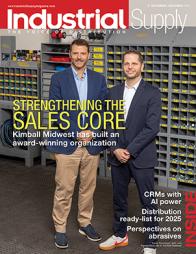What every warehouse manager should know
Ideas to make your warehouse more efficient
by Jason Bader
I have been a member of the social networking site LinkedIn for a few years. About six months ago, I ran across a particularly interesting query in one of the groups I belong to: What are some basic questions warehouse managers ask?
The gentleman who posted the query, Simon Walker of Raymond Handling Solutions, was trying to get better insight into the concerns of his customers. Based on the volume of responses from members of the group, it was one of the more successful posts I have seen. Although Simon and I approach the information from different perspectives, we both agreed this would make a great article.
Rather than hit each topic in depth, I will give you the most frequently mentioned areas for further self-study. This article is designed to help you focus attention on the most popular concerns so that training and education can be designed.
Warehouse Safety and OSHA
Loss of personnel hours due to unsafe working conditions has to be top of mind for the warehouse manager. Look at equipment training programs and using the right tool for the job. How many times have you seen someone ride the forks to grab something from a high elevation? Watch for elevation changes, such as mezzanines and ramps and uneven flooring surfaces. These are often the source of injury.
Many warehouse folks see OSHA as an intrusive enemy that comes to levy fines. While the agency does have an enforcement mandate to penalize companies for unsafe working environments, it also has a preventative outreach program. Many of my clients have invited the prevention side to inspect their facility. The inspector will make recommendations and give the company time to comply. None of my clients has regretted the invitation.
Productivity
Understand workflow. How does material flow through the warehouse? Are their certain times of day that receiving is the heaviest? Scheduling incoming freight can help you manage the workflow more effectively. Conversely, creating a day-end close to the flow of order picking will allow you to clean up loose ends before the next work day. The goal is to do more with the same number of team members without generating errors.
Slotting and Organization
Decisions around where to place inventory will allow you to pick orders more efficiently and help keep your team members safe. From a productivity standpoint, I am a proponent of moving your most popular items closest to the shipping doors. From a safety standpoint, make sure your most popular items are located in the strike zone. You don't want to make a picker reach too high or lift too many times in a day. Also, your fastest moving items should never be on a mezzanine. If you have bin locations in the facility, and you should, make sure that you have a bin map near the pick ticket printer.
Preventative Maintenance
Nothing kills productivity like a broken piece of material handling equipment. I have seen forklifts go down when a pallet-ladened trailer barely kissed the dock bumpers. Imagine my mood when I discovered that the pneumatics were shot on the pallet jack. All this could have been avoided with a preventative maintenance program. Checklists, either weekly or daily, help warehouse managers keep on top of all of their material handling assets. Don't forget to inspect racking and dock equipment.
Boxes and Containers
From a customer service perspective, be very conscious of the way orders and transfers reach their intended destination. Many distributors use old boxes to fill customer orders. Re-using and recycling materials is good, but not at the expense of damaged product. New boxes may seem prohibitively expensive, but have you considered offsetting the cost by vendor co-op advertising funds? Would your suppliers pay for their logos to be seen by your customers? With regard to larger orders or transfers, consider Gaylord boxes. These pallet sized, reinforced cardboard boxes are an economical way to protect products in transit.
Staffing and Management
Why do you expect the people who manage all of your cash (the inventory) to work for minimum wage? Many distributors pay more, but how many have a variable compensation program based on performance? Come up with five criteria to measure. These can change over time. Make sure that it is a team incentive paid on a monthly basis. If the team hits all five goals, the amount you pay will be a pittance compared to the money you saved in sloppy material handling.
Training and Education
Have you ever spent time teaching your material handling team about the big picture? Since a vast majority of distributors promote from within, educating your team on distribution, product and customer service is an investment in your future. One of the most critical components in the order transaction is the delivery driver. Are you helping them project the right image to your customers? Most warehouse training is through osmosis: The new guy shadows the old guy. The old guy learned from the dead guy and you hope the dead guy did it right. Investing in outside warehouse training on a regular basis will prevent generations of bad habits.
Shipping and Receiving
For every one mistake made in receiving, 10 additional errors are generated in the warehouse. Cleaning up these errors is where distributors balloon their operating expenses. Make sure that your strongest team member is in charge of receiving. Get it right the first time. Give the receiving team plenty of room to work. They have to break down pallets, count, cross dock, filter out supplier errors, re-label, etc. They need room to get all this right.
Separate shipping and receiving. Shipping teams often need to double check and package customer orders. They need to stage orders, load them into carriers and make sure that branch transfers are handled efficiently.
On average, distributors carry 25% to 30% more inventory than they need to provide superior customer service. Reduce the number of pallet racks in the warehouse. Increase the space allocated to shipping and receiving functions. You will make fewer mistakes and reduce the amount of money spent on cleaning up after the fact.

Jason Bader is managing partner of The Distribution Team, which specializes in helping distributors become more profitable through operating efficiencies. He spent the first 20 years of his career working in distributor operations. Today, he is a regular speaker at industry events and spends much of his time working with individual distribution companies. For more information, call (503) 282-2333 or contact him at Jason@Distributionteam.com or www.thedistributionteam.com.
This article originally appeared in the Nov./Dec. 2010 issue of Industrial Supply magazine. Copyright 2010, Direct Business Media.
<a href="http://www.numinagroup.com/">Numina</a>











